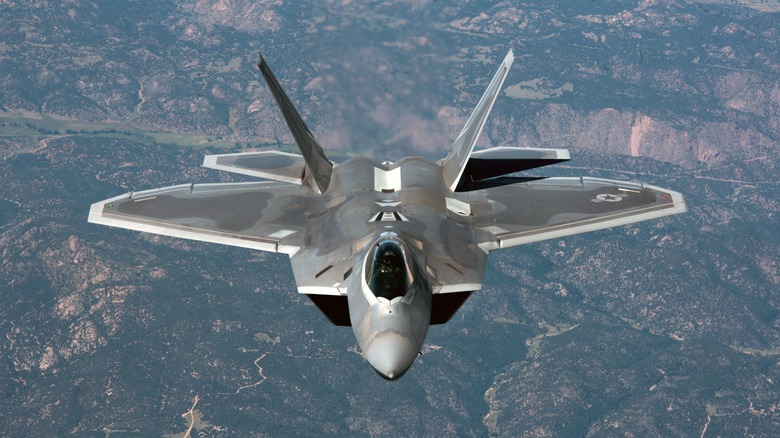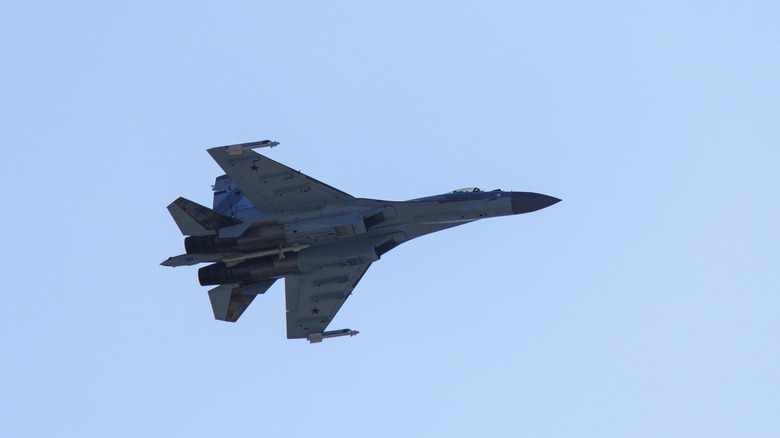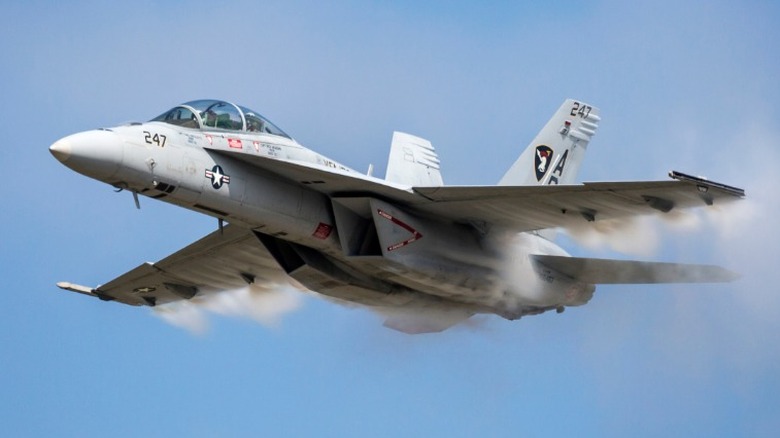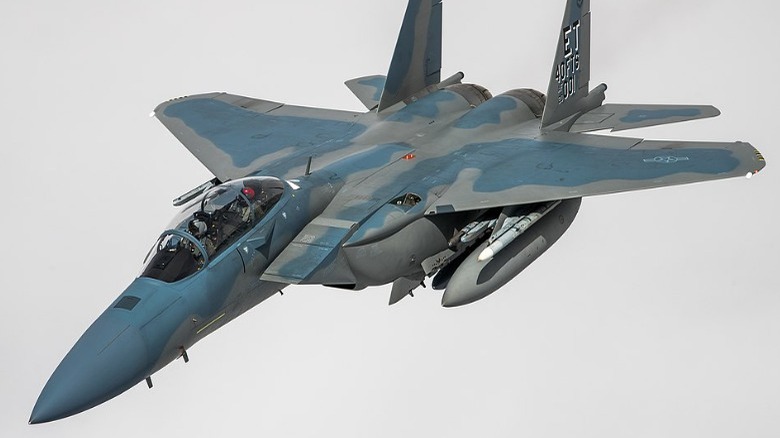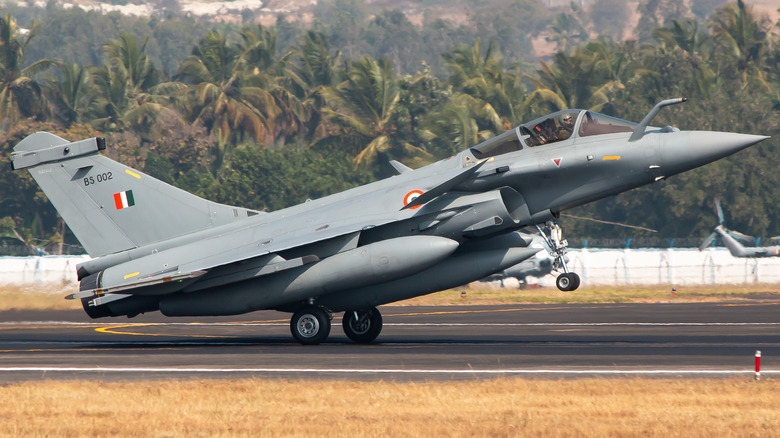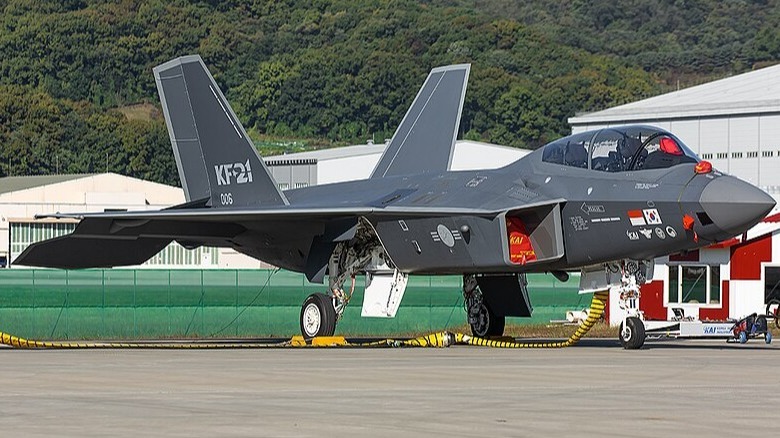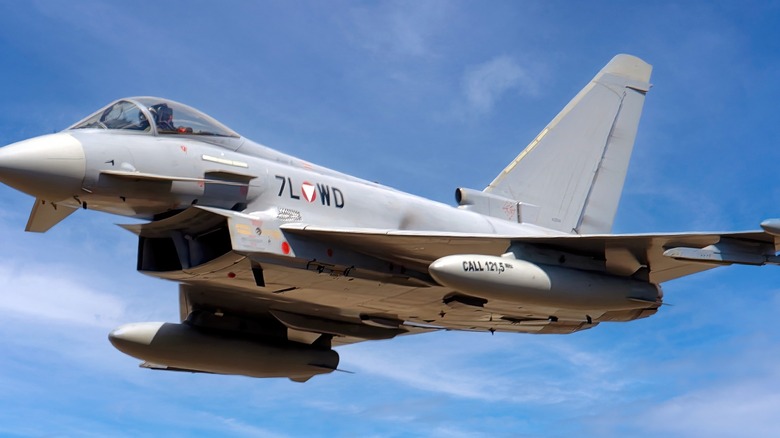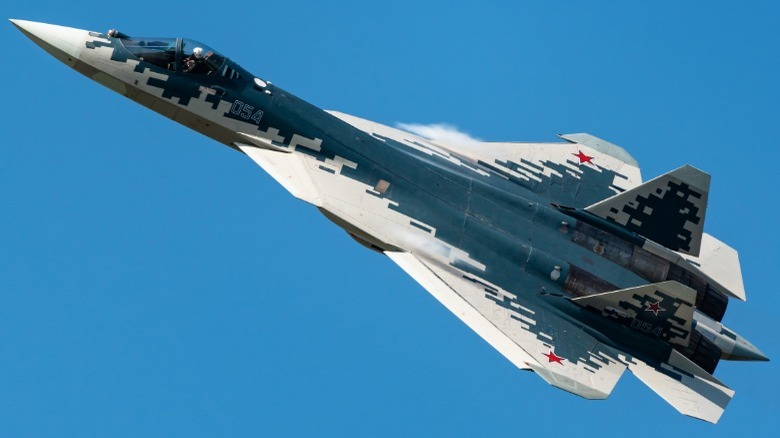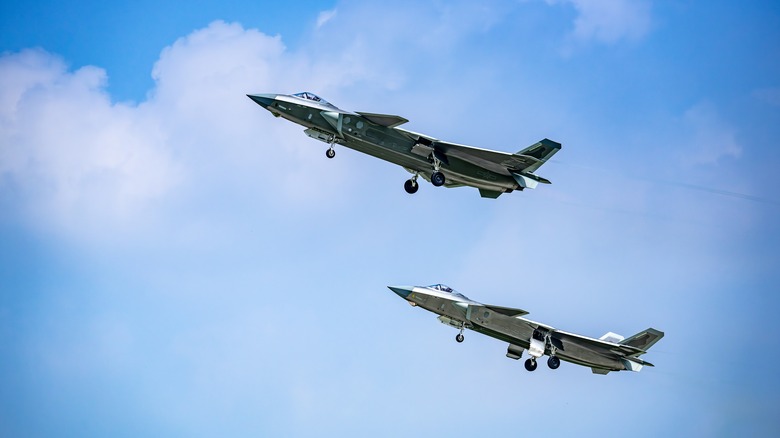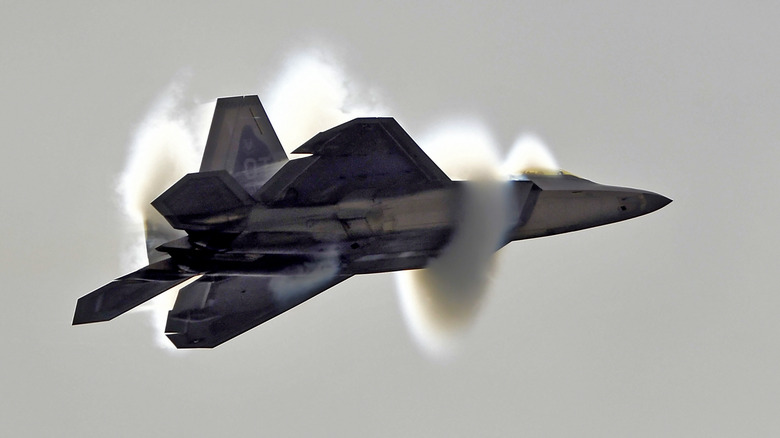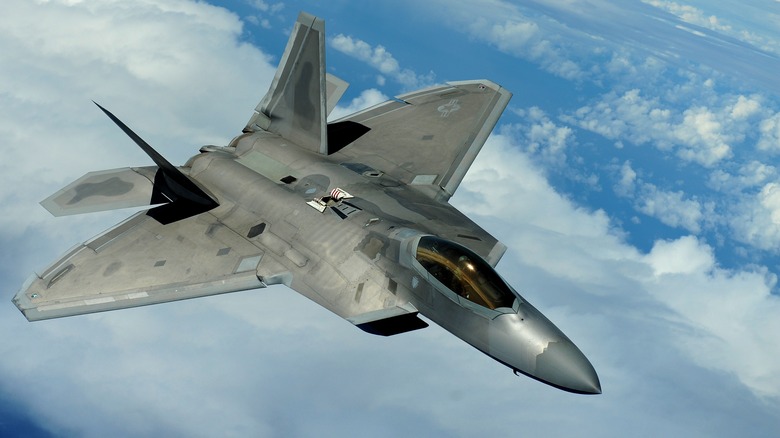10 Of The Most Advanced Fighter Jets Currently Flying In 2024
If you want to determine which is the best fighter jet in the world, you could look at raw performance numbers like top speed or maximum ordnance load, or look at how successful it has been in combat. You could look at how many have been exported to countries around the world, or even the sheer number of aircraft built since its introduction.
However, all of those have limitations. After all, fighters very rarely engage in direct combat with other aircraft and many fighters can't be exported out of the country of origin due to security concerns. A good way of deciding just how impressive a fighter actually is involves looking at the aircraft's overall capabilities. This takes into account all of the technology, equipment, weapons, and avionics of a fighter to get a more complete view of how well it can perform and what it is capable of.
When looking at the most advanced fighters currently in operation, these are the aircraft that stand out as the best of the best.
Sukhoi Su-35
Although MiG fighters may be the most famous of Russia's air force, the Sukhoi Su-27 and its successors may well be the most deadly and advanced. In fact, the Su-27 was among the Cold War fighters America feared most thanks to its high speed maneuverability, and heavy payload of weapons. So it makes a lot of sense that the successor fighter, the Sukhoi Su-35, was just as formidable and ranks as one of the most advanced fighters still in operation today.
In many ways, the Su-35 is very much a derivative of the Su-27, and takes the basic design and layout of the existing aircraft as a starting point. Testing began in the late 1980s and the fighter operated for some time under the designation Su-27M before it was switched to the Su-35 in an attempt to help attract customers. This new fighter has canards to help it make sharper turns in the air, have a higher angle of attack, and withstand greater g-forces.
Although it is outmatched by the more modern Su-57, the fighter is still a fearsome aircraft that can pack a punch. Operated by Russia and China, the Su-35 has a maximum speed of Mach 2.25 (or 1,500 mph) and can cruise at Mach 1.1. The fighter also has a maximum altitude ceiling of 59,000 feet and a range of 2,200 miles.
F/A-18 Super Hornet
While the United States Air Force opted for the F-16 Fighting Force, the U.S. Navy felt that a twin-jet fighter would be more appropriate for launching from aircraft carriers. That led to the development of a completely new fighter in the form of the F/A-18 Super Hornet. Development began on the fighter as far back as the late 1980s, with testing starting in the early 1990s and continuing until it entered into service in 1999. Based on the earlier McDonnell Douglas F/A-18 Hornet, which served during the Cold War, it serves as both a fighter and an attack aircraft — as noted by its F/A designation.
Along with its agility, the F/A-18 Super Hornet can serve this dual role largely thanks to the fact it has such a powerful array of weaponry it can call upon. In addition to a standard Vulcan 20mm cannon, the Super Hornet can be armed with everything from AIM-9 Sidewinder missiles to Paveway laser guided bombs. This allows it to engage a variety of different targets in a range of environments and conditions.
Although it isn't the fastest fighter, the Super Hornet can still reach a top speed of Mach 1.8 and a maximum altitude of 50,000 feet. The aircraft is also equipped with a touchscreen control, a digital fly-by-wire system, and a flight-control system that automatically detects any damage and adjusts to ensure the fighter stays in the air.
F-15EX Eagle II
The F-15EX Eagle II is one of the most recent additions to the United States Air Force. Based on the earlier F-15, it is a multirole fighter intended to replace the older F-15C/D variant. Development only started on this project in the early 2010s and it is not technically expected to enter active service until July 2024, although the USAF has already taken delivery of several batches. While it is designed to carry out a number of mission types, it was developed to supplement the smaller F-22 fleet in providing air superiority.
Obviously, the F-15EX Eagle II can't compete with the F-22 when it comes to stealth and evading anti-aircraft defenses. However, it is still an advanced aircraft with a string of notable improvements over its predecessor. There are additional missile stations and a digital fly-by-wire system, and the plane now uses the AN/ALQ-250 Eagle Passive Active Warning Survivability System. This can detect incoming attacks and deploy countermeasures as well as protecting against electronic warfare.
The fighter has a maximum speed of Mach 2.5 (or 1,650 mph) when at high altitude and a service ceiling of 60,000 feet. It also comes with the advantage of being far cheaper than both the F-35 and F-22, costing just over $80 million per unit. The is economical in other ways as well, as it is expected to have a lifespan of over 20,000 hours.
[Image by Ethan Wagner via Wikimedia Commons | Cropped and scaled | Public Domain]
Dassault Rafale
France was not part of the Eurofighter Typhoon project and instead embarked on its own fourth-generation fighter program. The result was the Dassault Rafale, a multirole fighter that is now operated by France, Egypt, Croatia, Greece, and India. Dubbed a 4.5-generation fighter, the Dassault Aviation aircraft can take on multiple duties, ranging from air superiority to surveillance and reconnaissance. Like many similar fighters, it is also capable of carrying out ground strikes and even has the ability to act as a nuclear deterrent as it can carry a number of nuclear armaments.
What you need to know about the Dassault Rafale is that it is intended to act as a bridge between the fourth and fifth-generation of fighters, able to be upgraded with new systems and match some of the capabilities of fighters such as the American F-35 and Chinese J-20. The aircraft comes in a twin-jet delta wing configuration, which gives it a distinctive appearance and ensures it can operate from land or sea.
One of the strengths of the Dassault Rafale is its agility and acrobatic abilities. The jet features front canards that are placed in the perfect position to perform extreme aerial maneuvers. Combine that with its top speed of Mach 1.8, a service ceiling of 50,000 feet, and avionics that include advanced radar and 3D map generation, and the Dassault Rafale is not to be underestimated.
KAI KF-21 Boramae
The KAI KF-21 Boramae is a multirole fighter that has been developed as part of a collaboration between Korea Aerospace Industries and Indonesian Aerospace for use by the militaries of both countries. While it is not technically in active service, the aircraft is due to be introduced in 2026 — it has conducted several flight tests, and the South Korean stealth fighter has fired a meteor missile, an advanced air-to-air weapon that can travel at four times the speed of sound and hit targets that are as far away as 120 miles.
Initially intended to operate at a spot between fourth and fifth-generation fighters, the Boramae is distinct for being entirely developed within South Korea and Indonesia, without direct assistance from the United States. As such, it doesn't have the same kind of stealth capabilities as the F-35 or F-22 but it features radar absorbent material and a cross-sectional design that should deflect some radar waves and make the aircraft much harder to detect.
Featuring a twin-jet configuration, the fighter is powered by two General Electric F414-GE-400K engines and has a maximum speed of Mach 1.8 (equivalent to 1,400 mph), with an expected combat range of around 620 miles. Those Meteor missiles will also help ensure that the KF-21 is one of the most heavily armed fighters in the world and a significant threat to any enemy aircraft that it comes up against.
[Image by AnShmat via Wikimedia Commons | Cropped and scaled | CC BY-SA 4.0]
Eurofighter Typhoon
The Eurofighter Typhoon is a fourth-generation fighter with a distinctive delta wing design that operates as a multirole aircraft, capable of carrying out missions such as bombing ground targets, providing surveillance, and establishing air superiority. A joint project between several European nations — including the U.K, Italy, Spain, and Germany — the Eurofighter Typhoon began development during the 1980s and made its maiden flight in 1994. Less than 10 years later, the fighter was introduced to the air forces of the European countries that built it.
Although it faced multiple delays due to problems with flight systems and the onboard computers, the Eurofighter Typhoon is one of the best fighters ever built. It has a maximum speed of Mach 2.35 (equivalent to 1,320 mph) and an operating range of 1,800 miles — significantly longer than the F-22 Raptor, albeit at a slower speed. The fighter can also carry a variety of missiles, ranging from air-to-air to anti-ship weapons, in addition to laser-guided bombs.
In terms of avionics, the aircraft features an active electronically scanned array known as the European Common Radar System developed especially for the fighter along with the Passive Infra-Red Airborne Tracking Equipment and Praetorian DASS, which helps detect incoming threats and deploy countermeasures automatically. The jet's unique shape also means it can turn in the air at a higher rate, making it an effective dogfighter.
Sukhoi Su-57
Throughout modern history, the technology of the Soviet Union and Russia has largely developed as a response to advancements made by the U.S. The Sukhoi Su-57 is no different in that respect. In development since the early 2000s, the first test flight for the Su-57 Felon took place in 2010 and it entered active service in 2020. This is a fighter that was designed entirely to compete with the U.S. fifth generation fighters, namely the F-22 Raptor and F-35 Lightning. However, Russia has only been able to produce just under two dozen Su-57s so far.
Undoubtedly the best fighter jet in the Russian military, the Felon will go on to replace the Su-47. As a fifth-generation fighter, the Su-57 Felon has stealth technology, although this is limited compared to comparable fighters. Rather than having a small radar cross section, the Russian aircraft depends on radar-absorbent materials. What really makes the Su-57 so advanced is its array of weaponry. It can come equipped with a variety of missiles — such as the R-37 Axeheads and Kh-38M — and an autocannon for close-range combat.
It can fly at 65,000 feet and reach a speed of Mach 2 at that altitude (up to 1,550 mph). A pair of Lyulka 117S engines provide the thrust, allowing it to climb a thousand feet in less than a second.
Chengdu J-20
The Chengdu J-20 is China's answer to the fifth-generation fighters of the United States and Russia. Nicknamed the Mighty Dragon, the Chengdu J-20 is a multirole fighter that leans more toward stealth and air superiority. In that sense, it is more of a rival to the F-22 Raptor than the F-35 Lightning II, although it certainly doesn't have the same capabilities as the U.S. aircraft.
The Chengdu J-20 made its very first flight way back in 2011 and then went on to enter active service with China's air force in 2017. In the seven years it has been in production, more than 200 units have been built and delivered, making it the second most common fifth-generation fighter in the world after only the F-35. The aircraft shares many similarities with the F-22 — largely due to the fact that China was able to steal plans for the fighter — and has some of the same technologies and stealth elements. This includes an array of radar absorbent materials to help stop electronic detection and sensors intended to confuse trackers.
However, it is the speed of the Chengdu J-20 that really makes it stand out as one of the most advanced fighters. It can reach a top speed of Mach 2.55 (or 1,650 mph) after engaging its afterburners, although the aircraft is limited to only being able to travel at that speed for a short amount of time. However, that is still enough to make it one of the fastest fighters ever.
F-35 Lightning II
Although the U.S. already had an advanced fifth-generation fighter in the form of the F-22 Raptor, the high cost of that aircraft meant that a cheaper alternative was needed. Authorities also wanted a fighter more versatile than the F-22 and didn't focus entirely on air superiority. The solution was the Lockheed Martin F-35 Lightning II, a joint collaboration between Lockheed Martin, Northrop Grumman, and BAE Systems.
The F-35 entered service within the United States Air Force in 2015, having made various test flights since 2006 when it first flew. While it is not as stealthy as the F-22, the Lightning II has plenty of strengths. In fact, the speed and range of the F-35 make it stand out in a field full of impressive fighters. It can travel at Mach 1.6 (roughly 1,185 mph) and stay in the air for 1,700 miles. It also comes equipped with an array of mission systems and avionics, all intended to improve the situational awareness of the pilot and allow the fighter to map a complete picture of the combat arena.
The F-35 has been a big success and its capabilities have been impressive enough for it to be exported to many countries around the world. NATO allies such as the United Kingdom and Canada count on the F-35, as do nations like Australia and Japan. It is little wonder, then, that more than 1,000 Lightning II fighters have been produced over the last two decades.
F-22 Raptor
Despite being relatively old — especially when it comes to fifth generation fighters — the F-22 Raptor remains one of the most advanced jets ever created. Officially designated the Lockheed Martin F-22 Raptor, it made its first flight almost three decades ago. Development of the aircraft can be traced back to the 1980s, with Lockheed Martin and Boeing eventually winning the contract. The project to replace the F-15 led to what is now widely regarded as the pinnacle of jet fighters.
A quick look at the F-22 Raptor reveals it has a lot of strengths. As an air superiority fighter, it is intended to take control of the skies and prevent any other aircraft from operating within its range. Unlike other more versatile fifth-generation fighters, the F-22 has a particular focus on stealth and maneuverability so it can dispatch enemy targets quickly and efficiently. Even without engaging its afterburners, it can cruise at a speed of Mach 1.5 and make sharp turns that other fighters are incapable of doing.
Combining a lightweight fiber composite body with a design and shape that makes it practically invisible to radar and electronic tracking systems, locking onto the F-22 is nearly impossible with current technology. That means it has a distinct advantage over any other aircraft in a dogfight. All of that comes at a price, though, and the F-22 is estimated to have cost the U.S. $350 million per unit to produce, leading to the government choosing to reduce its initial order from 750 to just 186.
